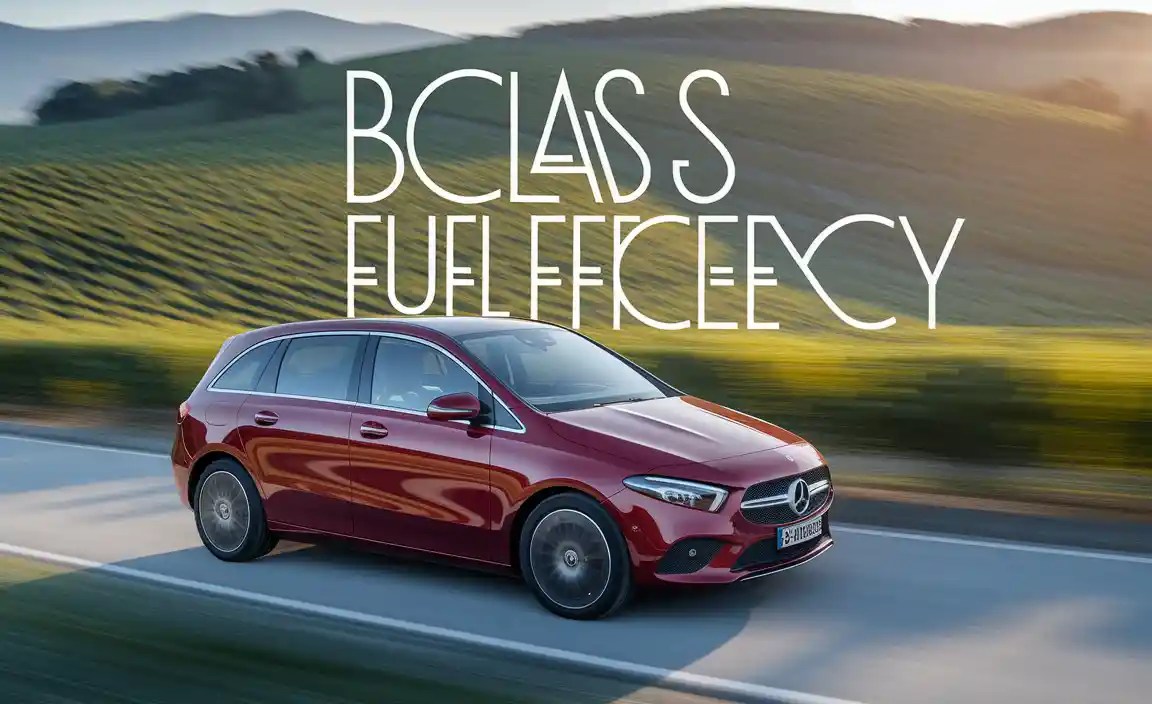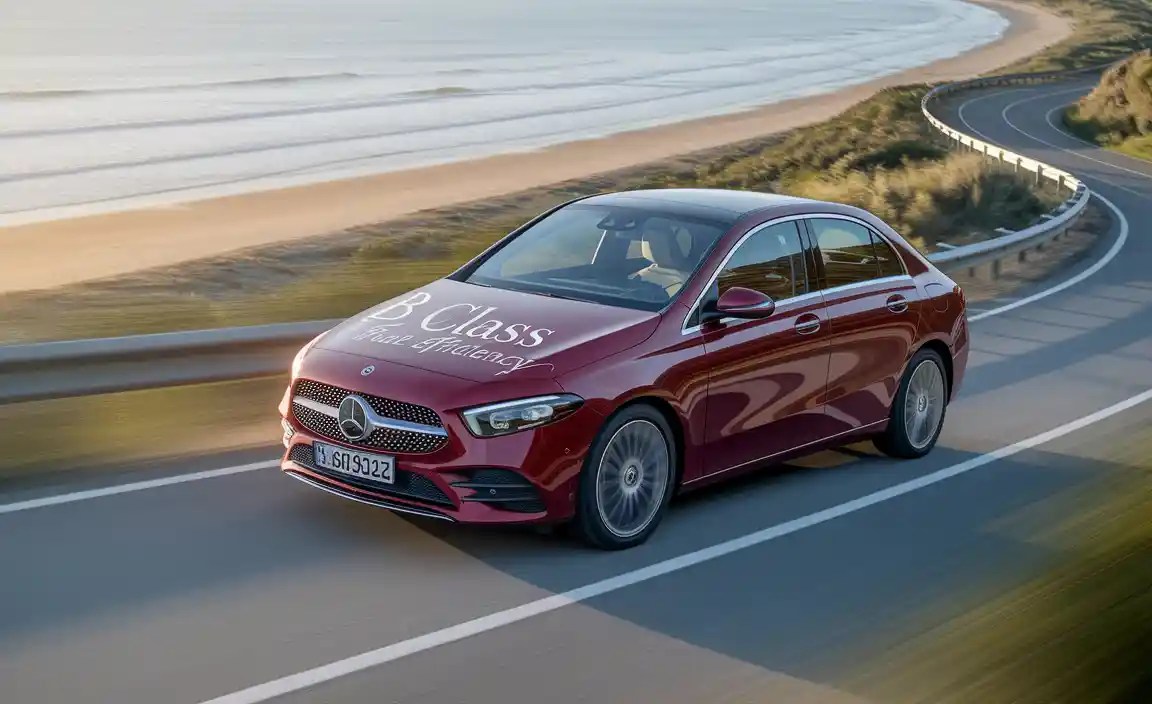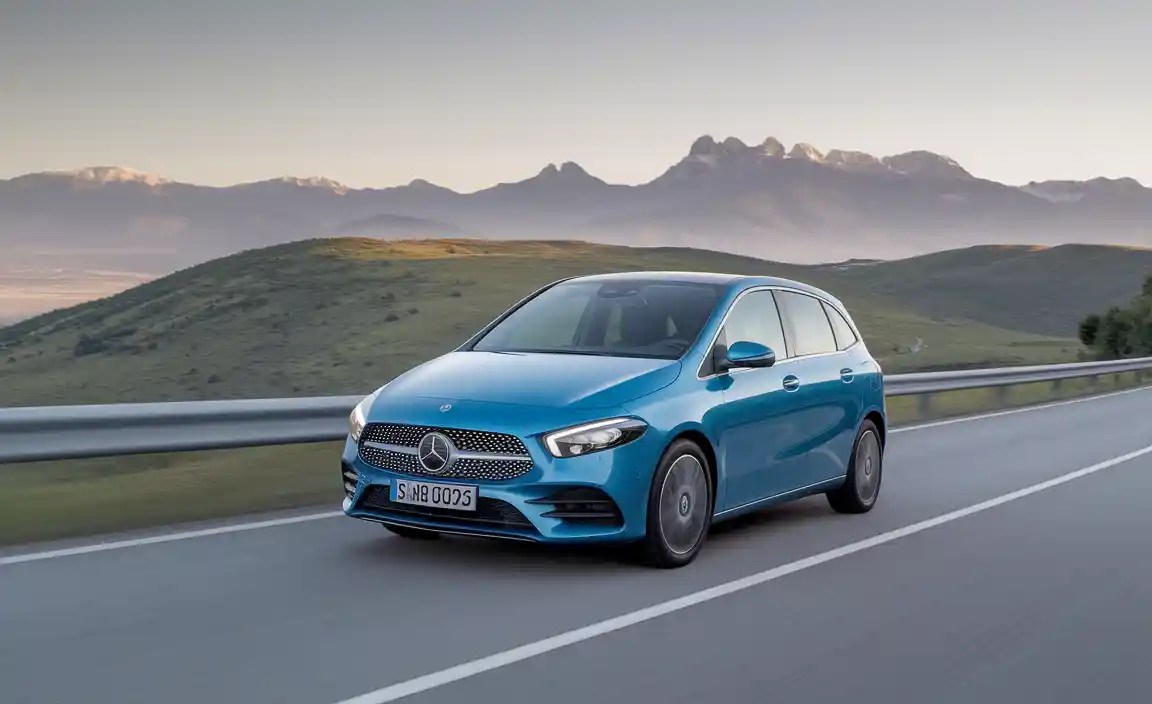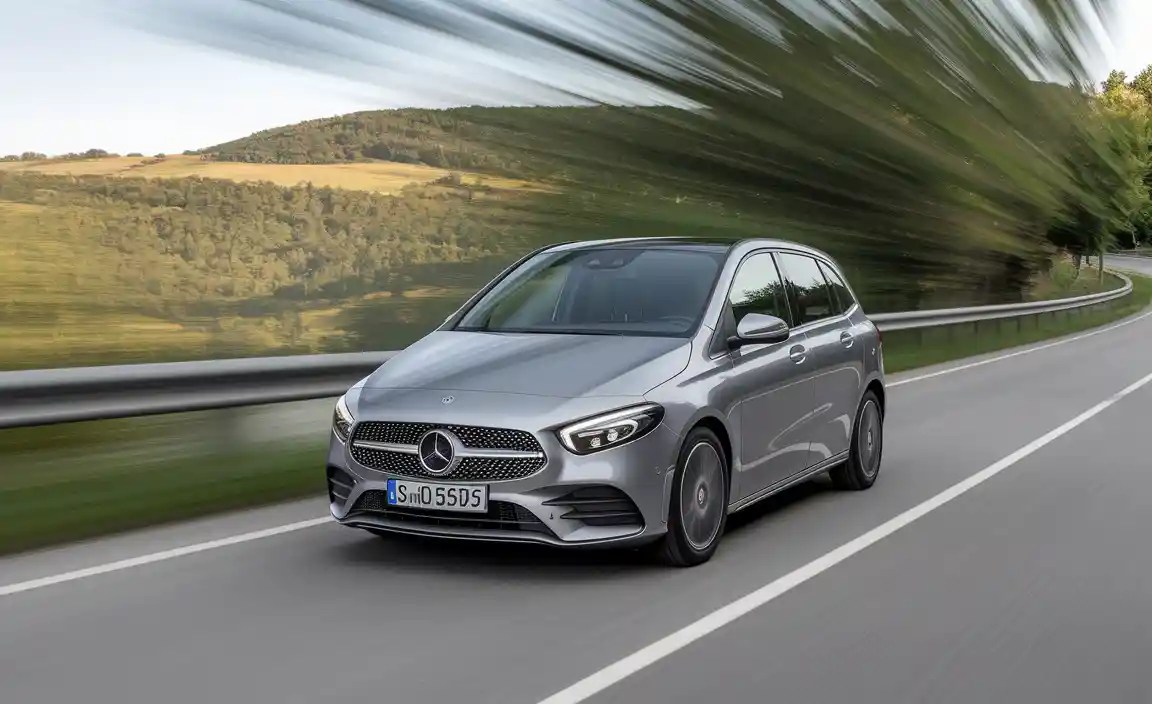B Class Fuel Efficiency: Effortless Luxury
Achieve remarkable fuel efficiency with your Mercedes-Benz B-Class without sacrificing its signature luxury. Discover easy-to-implement driving techniques and simple maintenance tips to maximize your MPG, making every journey more economical and enjoyable.

Welcome to MercedesBlue! Today, we’re diving into a question many of you have asked: “How can I get the most out of my Mercedes-Benz B-Class’s fuel economy?” It’s a common concern, especially with the rising cost of fuel, and it’s completely understandable.
You invested in a premium vehicle for its comfort, technology, and performance, not to watch the fuel gauge drop rapidly. The good news is that achieving excellent B Class fuel efficiency isn’t a mystery. With a few smart adjustments to your driving habits and some straightforward maintenance advice, you can enjoy that effortless luxury for longer between fill-ups.
This guide is designed to be your go-to resource. We’ll break down the simple yet effective strategies that can make a noticeable difference in your B-Class’s MPG. From understanding how your driving style impacts consumption to basic care that keeps your engine running optimally, we’ve got you covered. Get ready to transform your driving experience and embrace a more economical way to enjoy your Mercedes-Benz.
Understanding B-Class Fuel Efficiency
The Mercedes-Benz B-Class is a unique offering, blending the practicality of a compact car with the premium feel and technology synonymous with the brand. When we talk about its fuel efficiency, we’re looking at how effectively its engine converts fuel into forward motion. Several factors contribute to this, both inherent to the vehicle’s design and influenced by how it’s driven and maintained.

Mercedes-Benz engineers its vehicles with efficiency in mind, integrating technologies that help optimize fuel consumption. For the B-Class, this often means advanced engine management systems, aerodynamic design, and carefully calibrated transmissions. However, even the most sophisticated engineering can be undermined by poor driving habits or neglected maintenance. That’s where the driver’s role becomes paramount. By understanding these contributing factors, you can take proactive steps to enhance your B-Class’s fuel economy.
Engine and Powertrain Factors
The heart of your B-Class’s fuel efficiency lies within its engine and powertrain. Modern B-Class models typically feature efficient turbocharged gasoline engines. These engines are designed to offer a good balance of power and economy. Key components and systems that influence fuel efficiency include:
- Engine Displacement and Turbocharging: Smaller displacement engines, especially when combined with turbochargers, can provide the power of a larger engine when needed, but operate more efficiently during normal driving. The turbocharger forces more air into the combustion chamber, allowing for more power from a smaller engine, thus improving efficiency.
- Direct Injection: This technology delivers fuel directly into the combustion chamber at high pressure, leading to more precise fuel control and a cleaner, more efficient burn.
- Transmission: The B-Class often comes with an automatic transmission, such as the 7G-DCT (7-speed dual-clutch transmission). These transmissions are programmed to shift gears at optimal points to keep the engine in its most efficient operating range.
- Start-Stop System: Many B-Class models are equipped with an ECO Start-Stop function. This system automatically shuts off the engine when the vehicle is stationary (e.g., at a traffic light) and restarts it instantly when needed, saving fuel that would otherwise be consumed while idling.
To learn more about how Mercedes-Benz engines are designed for efficiency and performance, you can explore resources from the manufacturer’s official engineering pages, though these are often technical. For a simpler overview, imagine your engine like a finely tuned athlete; it performs best when it has the right support and is used correctly.
Aerodynamics and Weight
Beyond the engine, how your B-Class interacts with the air and how much weight it’s carrying significantly impacts its fuel consumption.
- Aerodynamics: The B-Class features a design that aims to minimize air resistance (drag). Features like its sleek profile, carefully sculpted body panels, and even the underbody panels contribute to pushing through the air with less effort. Drag increases exponentially with speed, meaning that driving faster requires much more energy (and fuel) to overcome air resistance.
- Vehicle Weight: A heavier vehicle requires more energy to accelerate and maintain speed. While the B-Class is designed to be relatively lightweight for its class, carrying unnecessary items in your car adds to its overall weight, directly impacting fuel economy.
Tire Pressure and Rolling Resistance
This is often an overlooked but critically important factor. The tires are your vehicle’s only point of contact with the road, and their condition and inflation level play a vital role.
- Tire Pressure: Underinflated tires create more friction with the road surface, known as rolling resistance. This means your engine has to work harder to move the car, consuming more fuel. Maintaining the correct tire pressure, as recommended by Mercedes-Benz, is crucial for optimal fuel efficiency and tire wear.
- Tire Type: Some tires are designed with lower rolling resistance as a primary feature, which can also contribute to better fuel economy.
You can find the recommended tire pressures for your B-Class on a sticker located on the driver’s side doorjamb or in your owner’s manual. Regularly checking and adjusting tire pressure is a simple yet highly effective way to improve MPG. For official guidance from the National Highway Traffic Safety Administration (NHTSA) on the importance of proper tire inflation, you can visit their tire safety page.
Driving Techniques for Better B-Class Fuel Efficiency
How you drive your B-Class has a profound impact on its fuel consumption. Adopting a few mindful driving habits can lead to significant improvements in your miles per gallon (MPG). These techniques are often referred to as “eco-driving.”

Smooth Acceleration and Braking
Aggressive driving, characterized by rapid acceleration and sudden braking, is a major fuel waster. Your engine works hardest when accelerating from a standstill or at higher rates. Smooth, gradual acceleration allows the engine and transmission to operate more efficiently.
- Accelerate Gently: Press the accelerator pedal smoothly and progressively. Imagine you have an egg under your foot. Start from a stop without flooring the pedal.
- Anticipate Traffic: Look ahead and anticipate slowdowns or stops. By easing off the accelerator early rather than braking at the last moment, you allow the car to slow down naturally, using less fuel and reducing brake wear. This is also known as ‘coasting’.
- Maintain Consistent Speed: Once at your desired speed, try to maintain it as consistently as possible. Frequent speed changes require more energy. Using cruise control on highways, where appropriate, can help with this.
Optimizing Gear Selection and Engine Speed
While modern automatic transmissions are very capable, understanding how they work with engine speed (RPM) can help you drive more efficiently.
- Let the Car Shift: For automatic transmissions like the 7G-DCT, allow the car to shift gears naturally. Avoid forcing it to downshift unnecessarily.
- Stay in Higher Gears: Higher gears operate at lower RPMs for a given speed. For example, driving at 40 mph in 6th gear will generally be more fuel-efficient than driving in 4th gear at the same speed because the engine is turning slower.
- Use ECO Mode: If your B-Class is equipped with a drive mode selector, engage the “ECO” or “Comfort” mode. These modes often adjust throttle response, transmission shift points, and climate control to prioritize fuel efficiency.
Minimizing Idling and Using Start-Stop Functionality
Idling your engine while stationary consumes fuel with zero miles gained. The ECO Start-Stop system is designed to mitigate this, but understanding its use is key.
- Turn Off the Engine: If you anticipate being stopped for more than 30-60 seconds (e.g., waiting for a long train, picking someone up), it’s more fuel-efficient to turn off the engine manually.
- Understand Start-Stop: Be aware of when your ECO Start-Stop system is active. It usually engages when completely stopped, the brake pedal is depressed, and the engine is warm enough. Ensure it’s not manually disabled if you wish to use it.
- Avoid Short Trips: Many of the B-Class’s fuel-saving technologies, like the Start-Stop system and optimal engine temperature, are less effective on very short trips. The engine may not reach optimal operating temperature, and the system might not engage as often.
Managing Climate Control and Accessories
The climate control system, especially air conditioning, can have a noticeable impact on fuel consumption.
- Use AC Sparingly: When possible, use the fan on its own or open windows at lower speeds. At higher speeds (above 40-50 mph), the aerodynamic drag from open windows can be less efficient than using the AC. Experiment to see what works best for your B-Class.
- Set and Forget: Once your desired temperature is reached, set the climate control to a moderate setting rather than constantly adjusting it.
- Reduce Electrical Load: While modern alternators are efficient, using power-hungry accessories unnecessarily can increase the load on the engine. Consider turning off features like heated seats or powerful stereos when not needed.
Proper Cruise Control Usage
Cruise control is a fantastic tool, but using it incorrectly can harm fuel economy.

- Use on Flat Highways: Cruise control is most effective on flat, open stretches of highway. It helps maintain a steady speed, preventing unnecessary acceleration and deceleration.
- Avoid in Hilly Terrain: On undulating roads, cruise control can cause the vehicle to accelerate aggressively uphill and then brake or decelerate downhill. In such conditions, it’s often more fuel-efficient to manually control your speed, allowing the car to coast downhill and gently accelerate uphill.
Maintenance for Optimal B-Class Fuel Efficiency
A well-maintained B-Class will naturally operate more efficiently. Regular servicing ensures all systems are functioning as intended by Mercedes-Benz engineers.
Regular Servicing and Oil Changes
Adhering to Mercedes-Benz’s recommended service schedule is paramount. This ensures that components are inspected, adjusted, and replaced as needed.
- Engine Oil: Use the correct grade and type of synthetic engine oil recommended by Mercedes-Benz. Clean, high-quality oil reduces friction within the engine, allowing it to run more smoothly and efficiently. Oil changes should be performed according to your vehicle’s maintenance schedule, often indicated by the “Service A” or “Service B” prompts in your dashboard.
- Air Filter: A clean engine air filter is essential for allowing the engine to breathe properly. A clogged filter restricts airflow, forcing the engine to work harder and consume more fuel. Replacing the air filter during routine maintenance is a simple yet effective way to maintain efficiency.
- Spark Plugs: Worn spark plugs can lead to incomplete combustion, reducing power and increasing fuel consumption. Ensure they are checked and replaced at the recommended intervals.
Tire Maintenance and Alignment
As mentioned earlier, tires play a crucial role. Beyond checking pressure, consider:
- Tire Pressure: Check your tire pressure at least once a month and before long trips, when tires are cold. Use a reliable tire pressure gauge.
- Tire Rotation and Balancing: Regular tire rotation ensures even wear, which helps maintain optimal rolling resistance. Properly balanced tires also contribute to a smoother ride and better fuel economy.
- Wheel Alignment: Misaligned wheels can cause tires to drag or scrub against the road, significantly increasing rolling resistance and fuel consumption, as well as causing uneven tire wear. If you notice your car pulling to one side or uneven tire wear, have your alignment checked by a qualified technician. According to Bosch Auto Service, proper alignment is key for safety, tire life, and fuel efficiency.
Keeping Your B-Class Tuned Up
A “tune-up” traditionally involved many checks, but in modern vehicles, it’s about ensuring the engine is running perfectly.
This can include:
- Fuel System: Ensure fuel injectors are clean and the fuel system is free of obstructions. If you notice any hesitation or rough running, have it investigated. Using high-quality fuel can also help.
- Oxygen Sensors: These sensors monitor the amount of oxygen in the exhaust and help the engine management system adjust the fuel-air mixture for optimal combustion. A faulty oxygen sensor can significantly impact fuel economy.
- Check Engine Light: Never ignore a “Check Engine” light. It’s an indicator that a sensor or system is not functioning correctly, and this can often lead to reduced fuel efficiency. A diagnostic scan can reveal the issue.
Weight Reduction Strategies
“Lighten the load” applies to both driving habits and what you carry.
- Remove Unnecessary Cargo: Regularly clear out your trunk and cabin of items you don’t need for your current trip. Even a few extra pounds add up.
- Roof Racks and Bike Carriers: If you’re not using a roof rack or cargo carrier, remove it. These items significantly increase aerodynamic drag, even when empty, and can reduce fuel efficiency by 5-15% or more.
Tire Choice
When it’s time for new tires, consider those designed for low rolling resistance. These tires are engineered to reduce the energy lost as the tire rolls, directly improving fuel economy. While they might have a slightly different feel or price point, the long-term fuel savings can be substantial.
FAQs
What is the average MPG for a Mercedes-Benz B-Class?
Average MPG for a Mercedes-Benz B-Class can vary depending on the model year, engine, transmission, and driving conditions. Generally, B-Class models offer competitive fuel economy for their segment, often ranging from the mid-20s to low-30s MPG in combined city/highway driving. For the most accurate figures for specific models, it’s best to consult official EPA ratings or reviews for your particular year and configuration.
Does driving in ECO mode really save fuel?
Yes, driving in ECO mode on your Mercedes-Benz B-Class can contribute to better fuel efficiency. This mode typically adjusts the accelerator pedal’s response, transmission shift points, and climate control system to prioritize economy over immediate performance. While it might make acceleration feel slightly less responsive, it encourages smoother driving and keeps the engine operating in more efficient parameters.
How often should I check my tire pressure?
It’s recommended to check your tire pressure at least once a month and before any long journeys. Tires can lose pressure slowly over time due to ambient temperature changes and small leaks. Checking them when the tires are cold (before driving for an extended period) provides the most accurate reading.
Is it better to use AC or open windows for fuel efficiency?
For fuel efficiency, it depends on your speed. At lower speeds (below approximately 40-50 mph), opening windows can be more efficient. However, at higher speeds, the aerodynamic drag created by open windows can actually reduce fuel economy more than using the air conditioning system. For highway driving, using the AC on a moderate setting is generally more efficient.
What role does engine oil play in fuel efficiency?
Engine oil is crucial for fuel efficiency because it lubricates moving parts, reducing friction. Less friction means the engine doesn’t have to work as hard to operate, consuming less fuel. Using the correct, high-quality synthetic oil recommended by Mercedes






